本文由 Nomadic Resorts 授权mooool发表,欢迎转发,禁止以mooool编辑版本转载。
Thanks Nomadic Resorts for authorizing the publication of the project on mooool. Text description provided by Nomadic Resorts.
Nomadic Resorts:该荒野海岸帐篷度假村坐落在斯里兰卡南部的亚拉国家公园边缘处,是一个由36个帐篷组成的野生动物园营地,其有机建筑与项目场上的干旱森林,与俯瞰印度洋的崎岖沙滩海岸线融为一体。作为五星级的生态度假村,其设计旨在通过结合当地的动植物和文化,尽量减少对自然环境的干扰,给游客提供一种亚拉(当地地名)式的亲密体验。该营地由Nomadic Resorts(建筑和景观设计)和Bo Reudler Studio(室内设计)组成的多学科团队为客户Resplendent Ceylon(Dilmah Tea的子公司)而设计,这种特色度假村所提供的斯里兰卡的历史、文化和自然相关的多样化体验吸引了各地不少好奇的旅行者。
Nomadic Resorts:Wild Coast Tented Lodge is a 36-tent safari camp located on the edge of Yala National Park, in the south of Sri Lanka. Its organic architecture integrates seamlessly into the site, which comprises dryland forests that merge into the rugged sandy coastline overlooking the Indian Ocean. The five-star eco-resort is designed to give visitors an intimate experience of Yala, celebrating the flora, fauna and culture of the area with minimal intrusion on the landscape. A multidisciplinary team consisting of Nomadic Resorts (architecture and landscape design) and Bo Reudler Studio (interior design) designed the camp for Resplendent Ceylon, a subsidiary of Dilmah Tea, whose unique resorts offer curious travellers diverse experiences linked to Sri Lanka’s history, culture and nature.

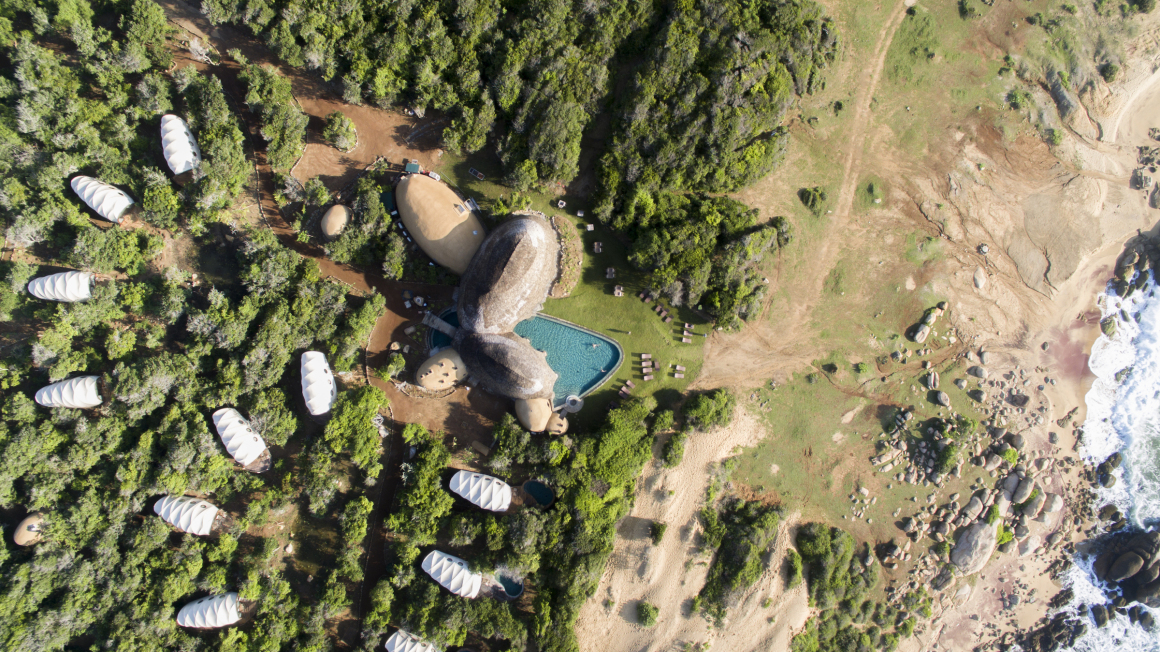
建筑 Architecture
亚拉当地的特色半干旱景观和海岸线上大量的裸露岩石,不仅是野生动物的栖息地,也是这片自然圣地真正的主人。为了与亚拉的自然景观相契合,度假村建筑都采用了巨大的圆形结构,与公园随处可见的白蚁土丘和蜂巢遥相呼应,营地的建筑在现有的宏观和微观形式之间融合创造了一种人性化的尺度感,又从这些有趣的自然形态衍生出了其它形式。保留下来的现有植被,营造出了真实的景观体验感。可以说,从传统文化、材料到社区参与,都是该项目不可或缺的一部分。
Scattered across Yala’s semi-arid landscape and along the coastline are massive rocky outcrops; these impressive landmarks provide habitat for wildlife and are host to sacred sites. These huge round formations are echoed at a micro scale by termite mounds and suspended beehives found throughout the park. To create a natural fit into Yala’s landscape, the architecture of the camp adopts a human scale between the existing macro and micro forms and derives its forms from these intriguing natural formations. The existing vegetation is retained to ensure an authentic experience of the landscape. Local influences form an integral part of the project, from vernacular traditions and materials to community involvement.
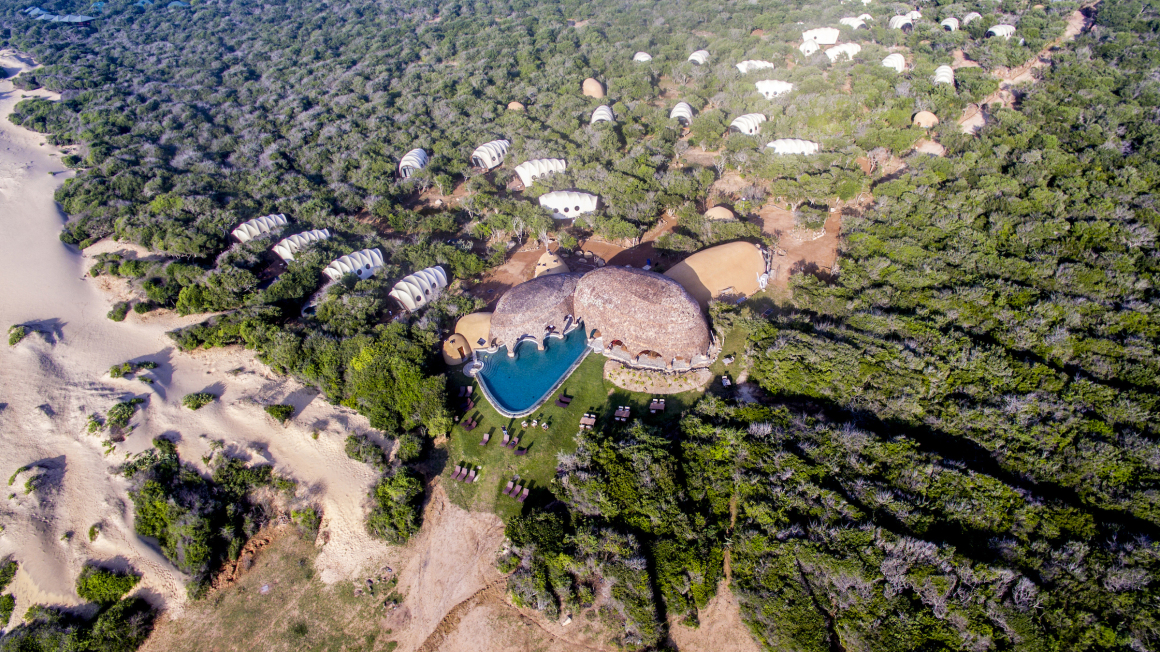
巨石般的展馆设施,有机地聚集在基地两端。较大的露天空间与拥有更多私人空间的较小封闭穹顶相交在一起。入口附近的迎宾区与滨水酒吧、餐厅和图书馆连接成一片蜿蜒的自然景观,两旁是一簇簇名为Loopers的茧状张力膜结构,每一簇结构都像一只豹子爪印,正对着吸引野生动物水坑。游客可以在帐篷前面的高架平台上安全地观赏野生动物。水疗中心也远离海滩,坐落在一片帕鲁树林中。
Positioned at either end of the site, the main facilities are organised as outcrops of boulder-like pavilions clustered organically together. Larger open air volumes intersect with smaller enclosed domes that house more private functions. Connecting the welcome area near the entrance with the waterfront bar, restaurant and library is a meandering natural landscape lined with clusters of cocoon-like tensile membrane structures called Loopers. Each cluster, which resembles a leopard paw print, overlooks a watering hole designed to attract wildlife. Guests can admire the wildlife from the safety of elevated decks at the front of their tents. The spa is set back from the beachfront, nestled amid a grove of Palu trees.
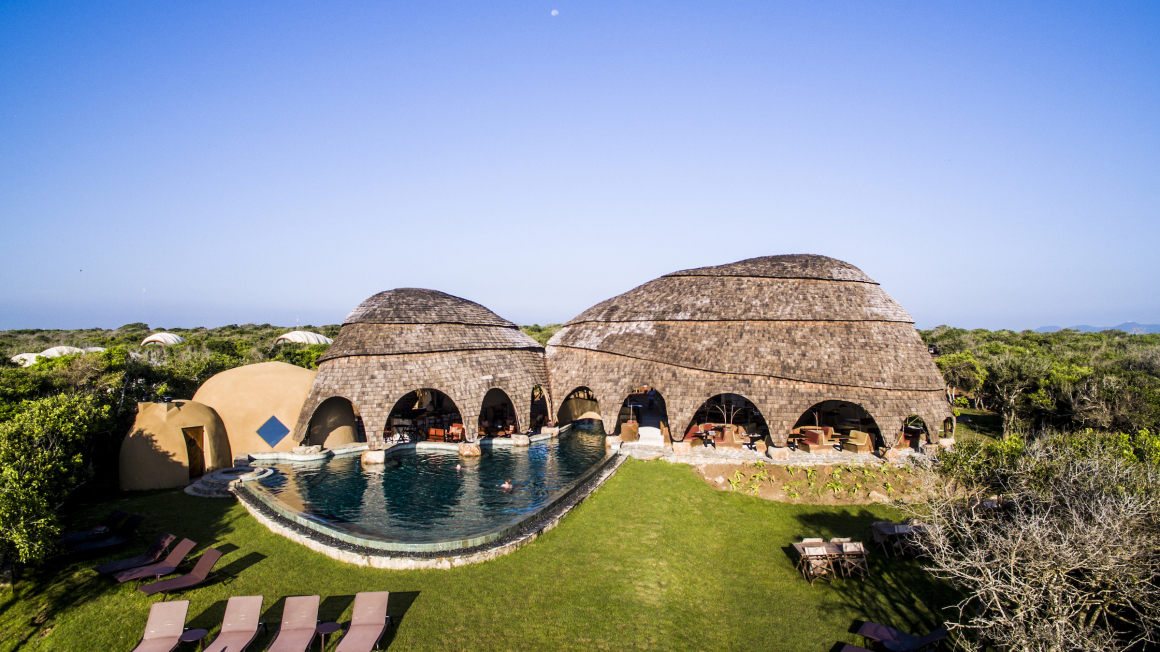
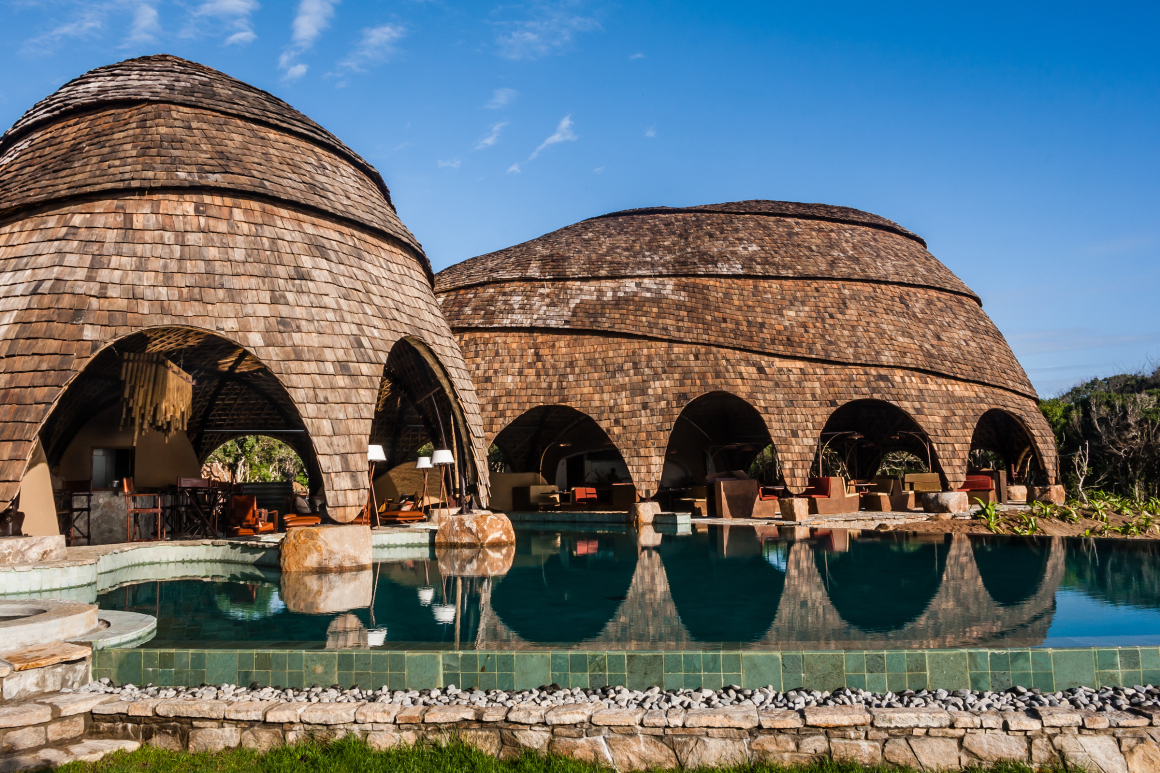
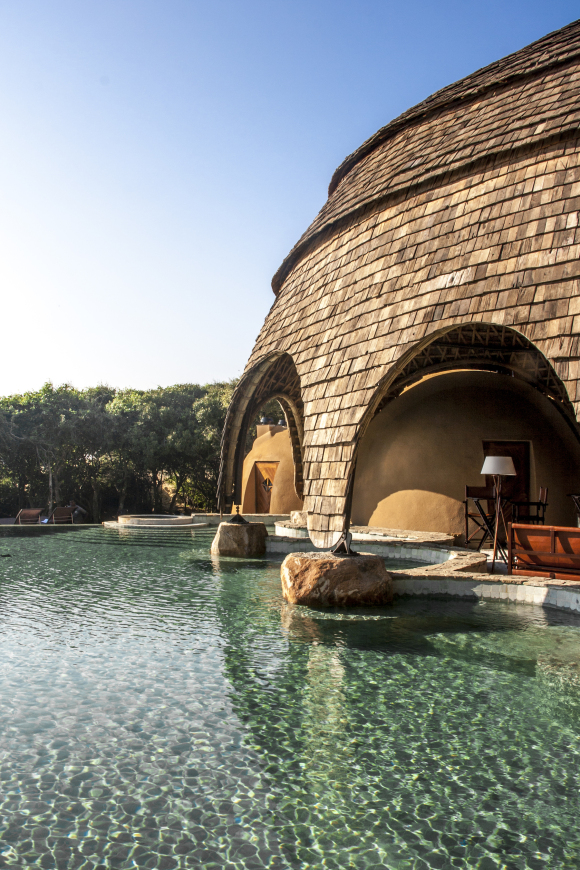
这些大展馆从远处看好像很坚固,但走近看,它们却是明亮又开放的轻盈结构。其拱形结构由网格壳竹精心编织而成,再覆以回收的柚木瓦。巨大的拱形开口和高高的拱形天花板营造出强烈的空间感,与此同时,同心圆的通风裂缝帮助将建筑体量减少到了更人性化的尺度。随着瓦片的风化,建筑将随着时间优雅地老化,形成一种天然的古铜色,与周围的石头相呼应。到了晚上,封闭的结构从外面被照亮,而开放的结构从里面被照亮,创造出诱人的光芒,灯火通明的展馆就像导航路标一样,排列在通风孔上的LED条带散发出引人注目的光圈更是进一步加强了这种效果。
From afar, the large pavilions appear solid but on closer inspection, they’re revealed as light, open structures. Their vaulted construction is crafted from a woven grid shell bamboo structure clad in reclaimed teak shingles. Large, arched openings and high vaulted ceilings create a strong sense of space while concentric ventilation slits help reduce the volumes to a more human scale. As the shingles weather, the buildings will age gracefully over time, and gain a patina that naturally complements the surrounding stone. By night, the illuminated pavilions appear as navigational landmarks – the enclosed structures are lit from the outside, while the open structures are illuminated from within, creating an inviting glow. This effect is accentuated by striking rings of light from LED strips that line the ventilation openings.
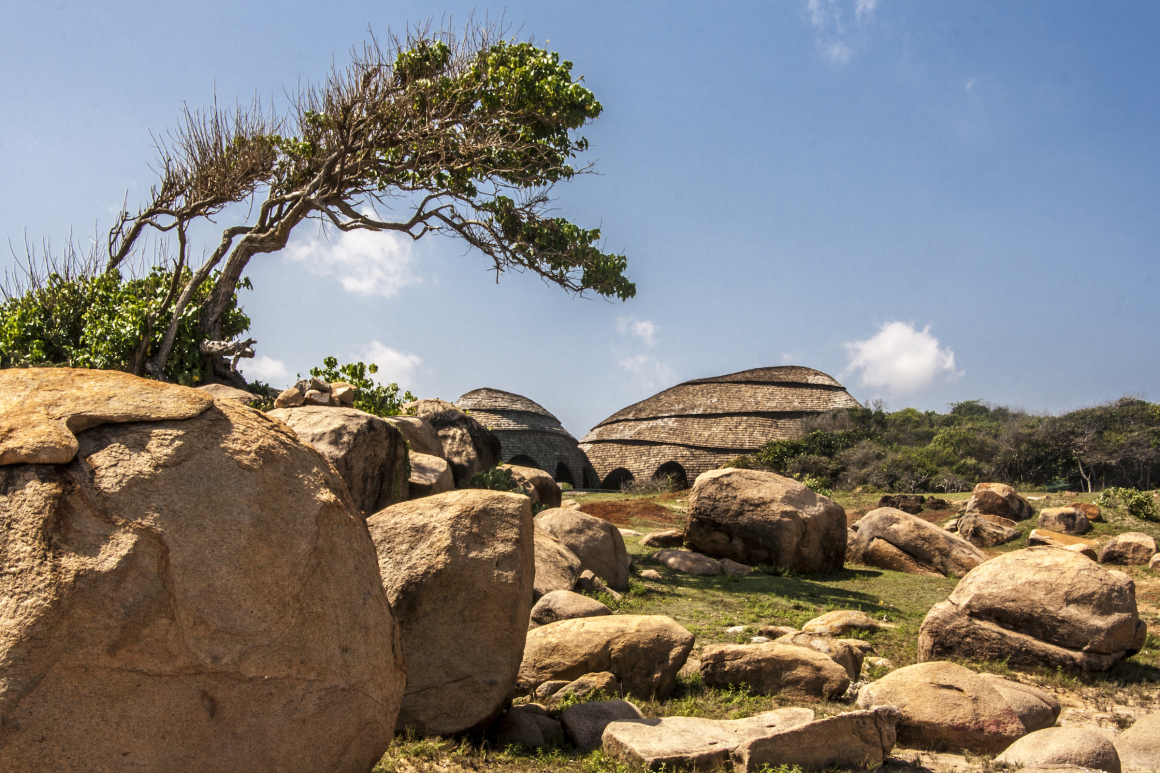
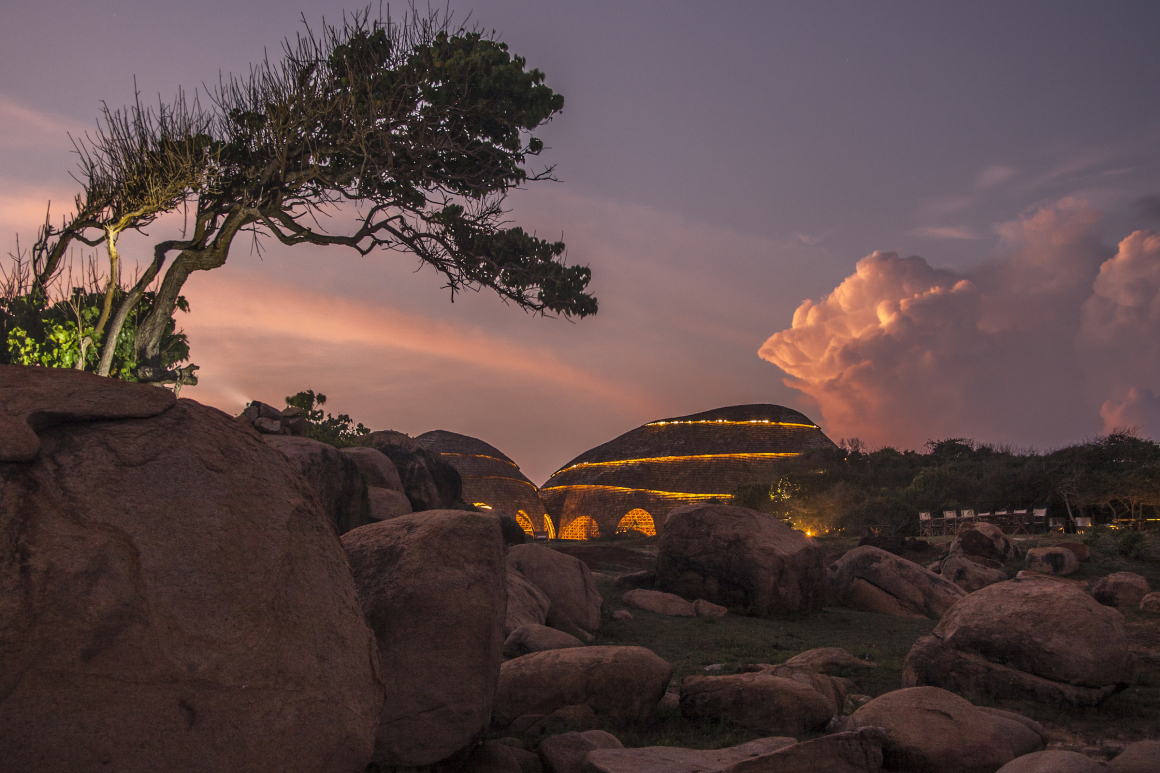
景观 Landscape
景观巧妙地利用了场地视野和资源方面的优势。在池塘挖掘过程中,我们发现场地底土主要由粘土和红土砾石组成,这种砾石通常是从河床中挖掘出来的,通常主要用于道路和道路铺面,对环境有害,因此,我们根据铺设道路所需的材料来确定池塘的大小,为了充分利用挖掘出的材料,还建造了一个特殊的旋转筛来分离砾石和粘土,用剩余的粘土来建造泥砖内部空间,从主水池中挖出的岩石则用于铺设小路的边缘。营地中点缀的一系列优雅的石头平衡雕塑,由艾德里安·格雷(Adrian Gray)用现场发现的石头专门创作而成。再利用能够承受长时间干旱的旱生植物,如龙舌兰、岩藻和三杉等,补充现有的植被,使其与建筑的曲线形式形成对比,同时降低对该地区自由游荡的野生动物的吸引力。
The landscaping cleverly utilises the qualities of the site, both visually and in terms of the resources. The excavation process for the ponds revealed a subsoil composed mostly of clay and laterite gravel commonly used for road and path surfacing. This gravel is often excavated from river beds, with detrimental environmental effects. The strategy therefore sized the ponds based on the material required for surfacing the pathways. To utilise the excavated material, a special rotating sieve was constructed to separate the gravel from the clay, which in turn, is used to create mud-brick interior features. Rock excavated from the main pool was used to edge the pathways. Dotted through the camp are a series of elegant rock balance sculptures by Adrian Gray created specifically using rocks found on the site. The existing vegetation is complemented by an attractive xeriscape of spiky plants such as Agave, Fucrea and Sanseveria that are able to withstand long drought periods and contrast with the curvilinear forms of the buildings. An additional advantage is that they are unappetizing to the wildlife that roams freely through the site.


室内 Interior concept
虽然建筑的外部形式偏向于巨石状,但其内部空间结合了奢华的生态和具备现代优势的优雅传统,仿佛隐藏在其中的宝藏,如洞穴、水晶和珍贵矿物的矿脉,有一种探索冒险的迷人感。石头、石英和泥砖等当地材料与丰富的铜、黄铜、水磨石、木材、竹子和纺织品搭配在一起,在呼应场地环境的同时,也突出了老化却优雅的高质量材料,以及点缀着主要空间的雕塑般的灯光装置。
Whereas the architecture focuses on the outer form of the boulders, the interior recalls the treasures concealed within them such as caves, crystals and veins of precious minerals. Capturing a sense of discovery, adventure and enchantment, the interior combines ecological luxury and local elegance with a contemporary edge. Echoing the context of the site, local materials such as stone, quartz and mud brick are paired with a rich palette of copper, brass, terrazzo, wood, bamboo and textiles. A strong focus is placed on high quality materials that age gracefully. Sculptural light installations punctuate the main spaces.

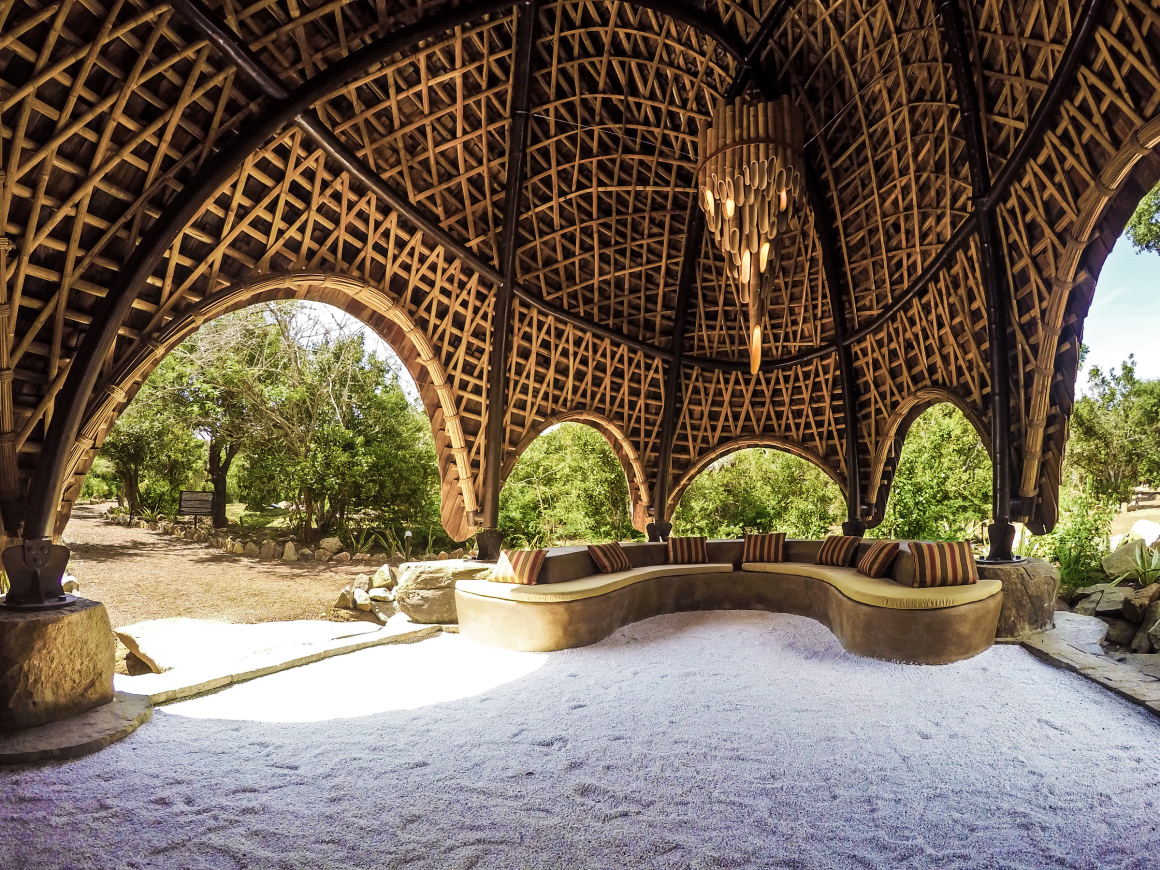
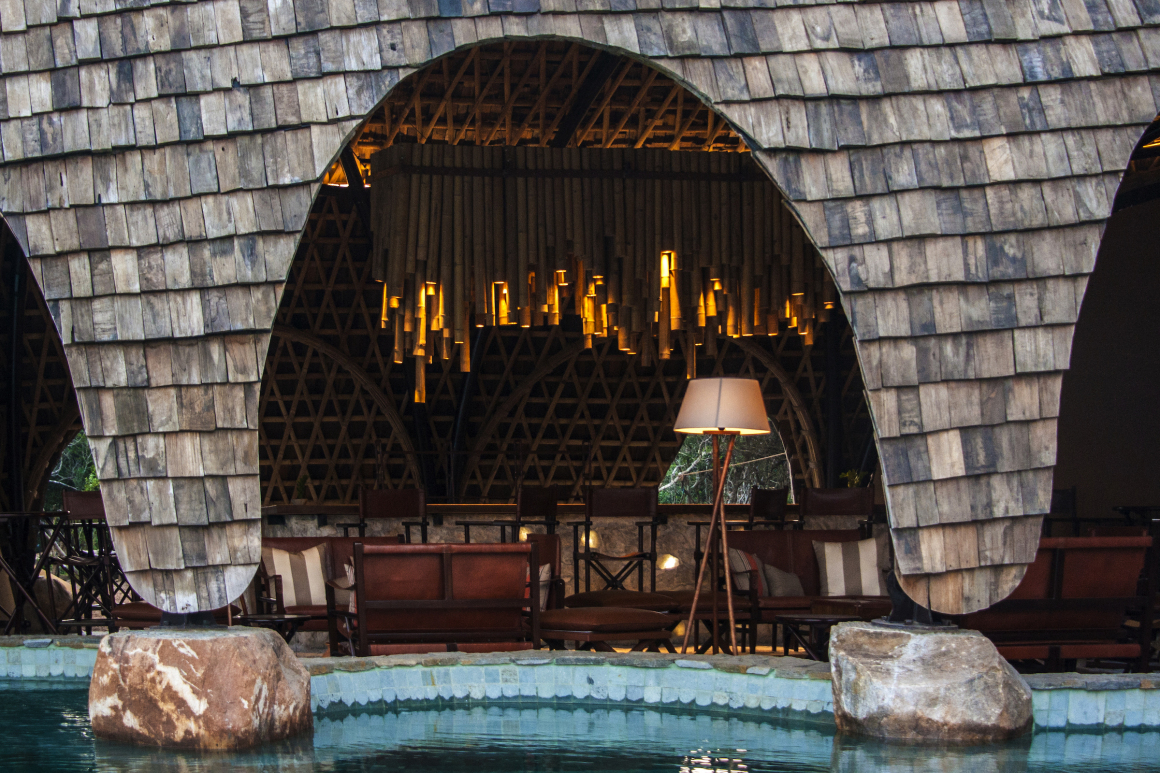
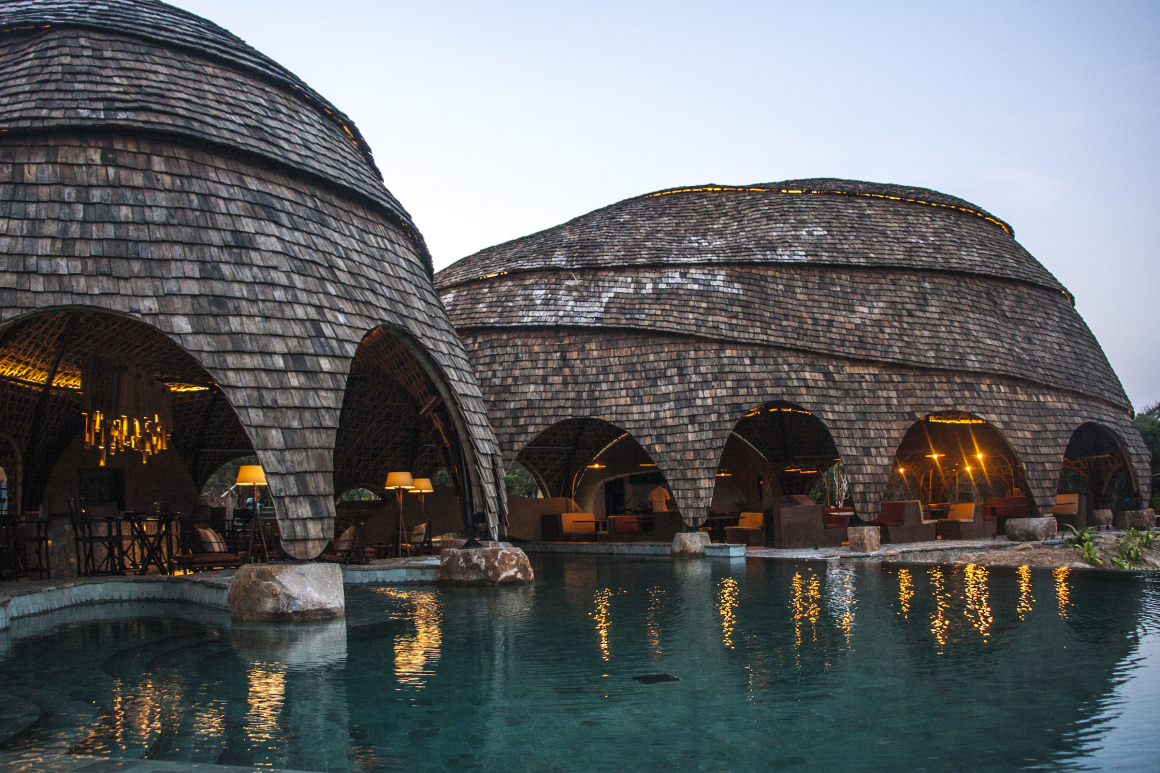
接待区 Welcome area
迎宾接待亭设置在入口大门附近,长途跋涉后的客人在这个开放区域获得接待,会有一种真正的到达感。接待亭内部的泥砖休息室拱顶上面配有特色的分层竹制枝形吊灯,其竹制穹顶的拱形开口与两个较小的封闭铁水泥穹顶相交,后者包含办公室和卫生间,外面覆盖着粗糙的卵石饰面。穹顶的开放端设有登记柜台,柜台背后是一面闪闪发光的石英墙,粗糙的石材外观与水晶般的内部形成对比,创造了一种在观察晶洞内部的美好错觉。
Located near the entrance gate, the welcome area creates a true sense of arrival. An open reception awaits guests after their long journey. The interior centres on a curved mud-brick lounge with an impressive tiered bamboo chandelier above. The arched openings of the bamboo dome of the welcome pavilion intersect with two smaller enclosed ferro-cement domes – containing the offices and washrooms – clad in a rough exterior pebble dash finish. The open end of the office dome incorporates the check-in desk backed by a sparkling quartz wall, creating the impression of looking inside a geode, with its rough stone exterior and crystalline interior.
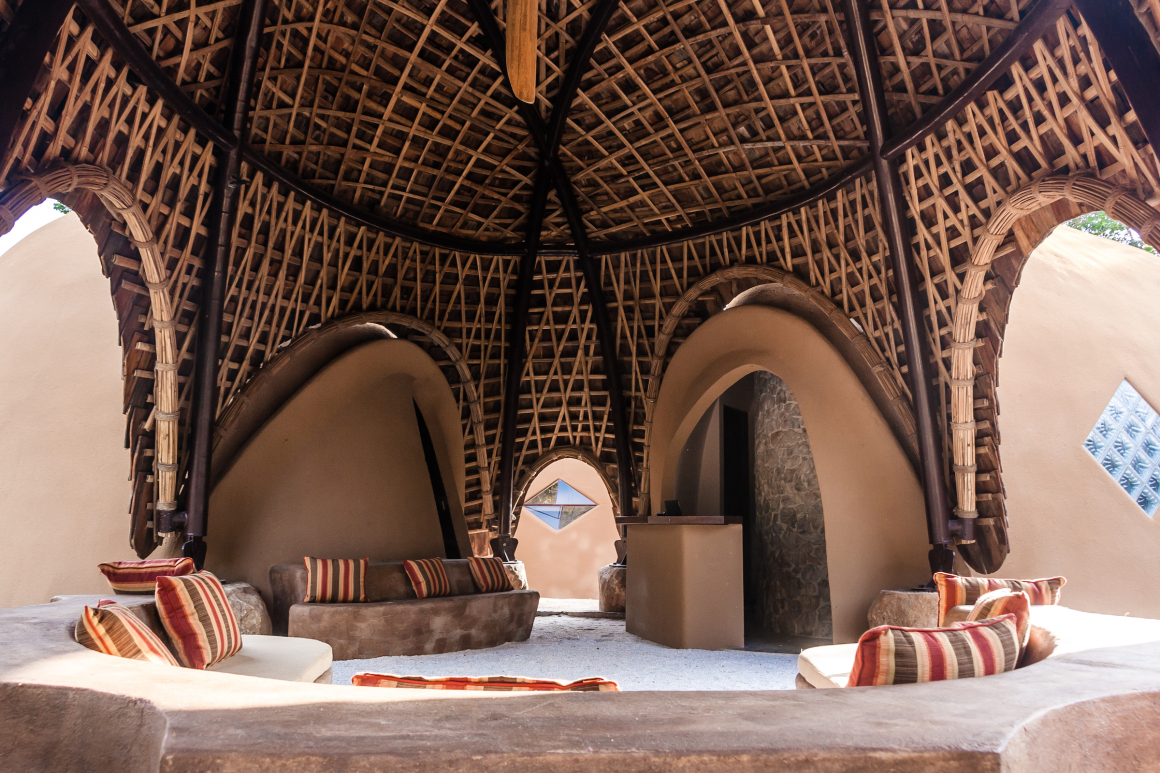
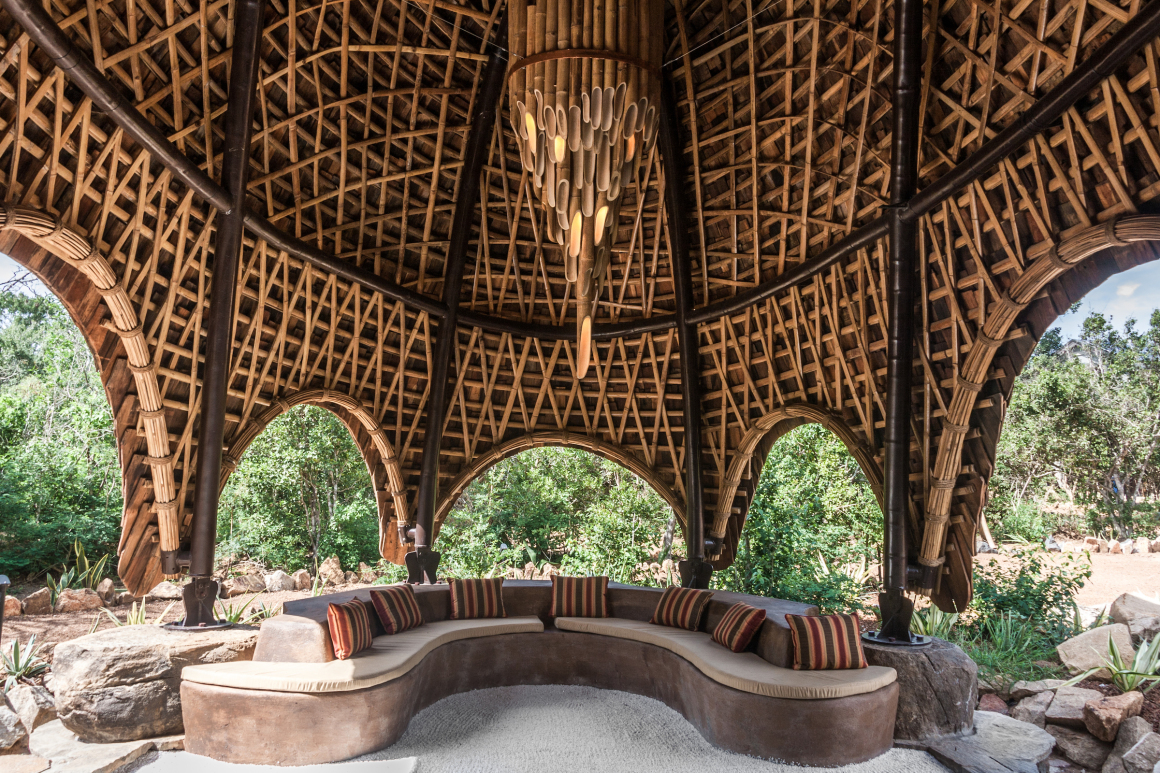
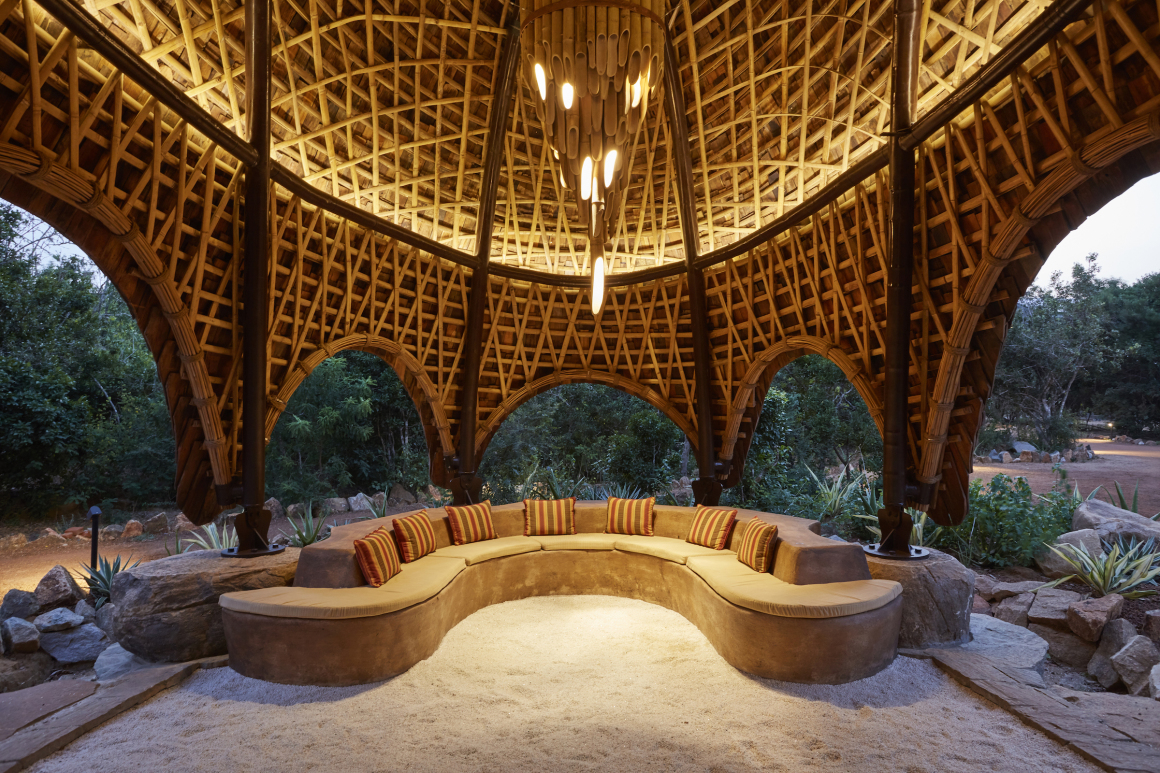
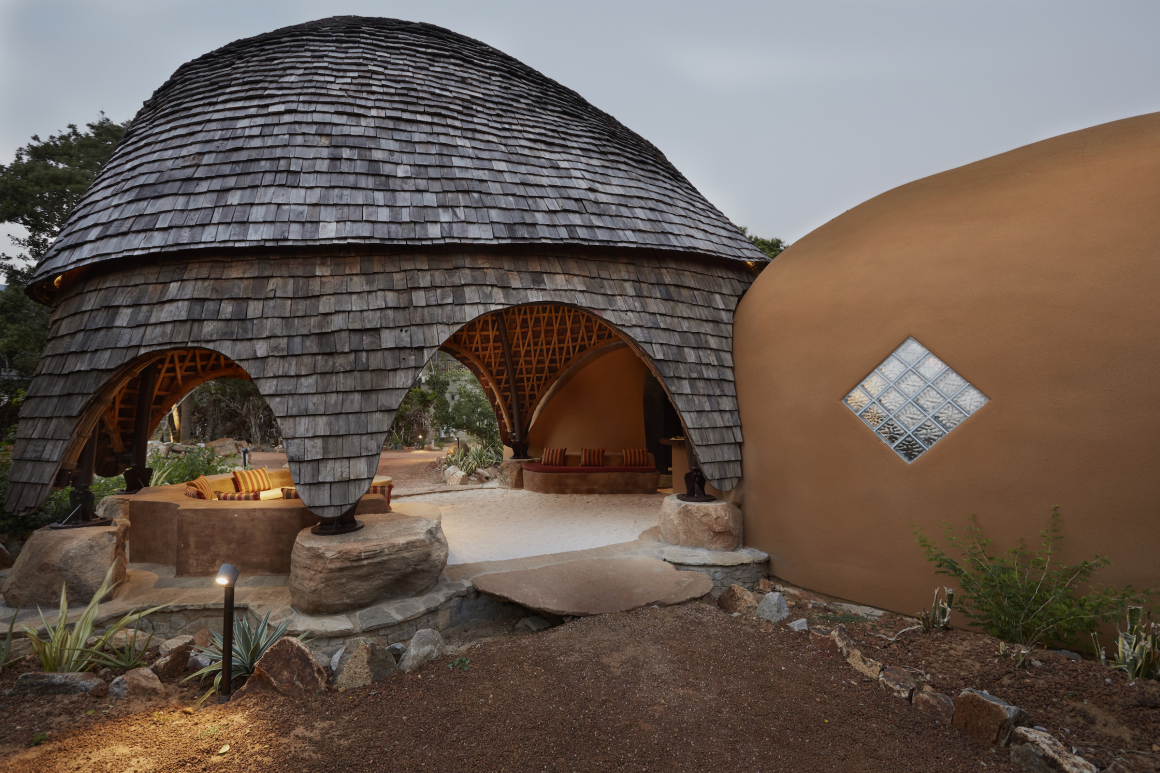
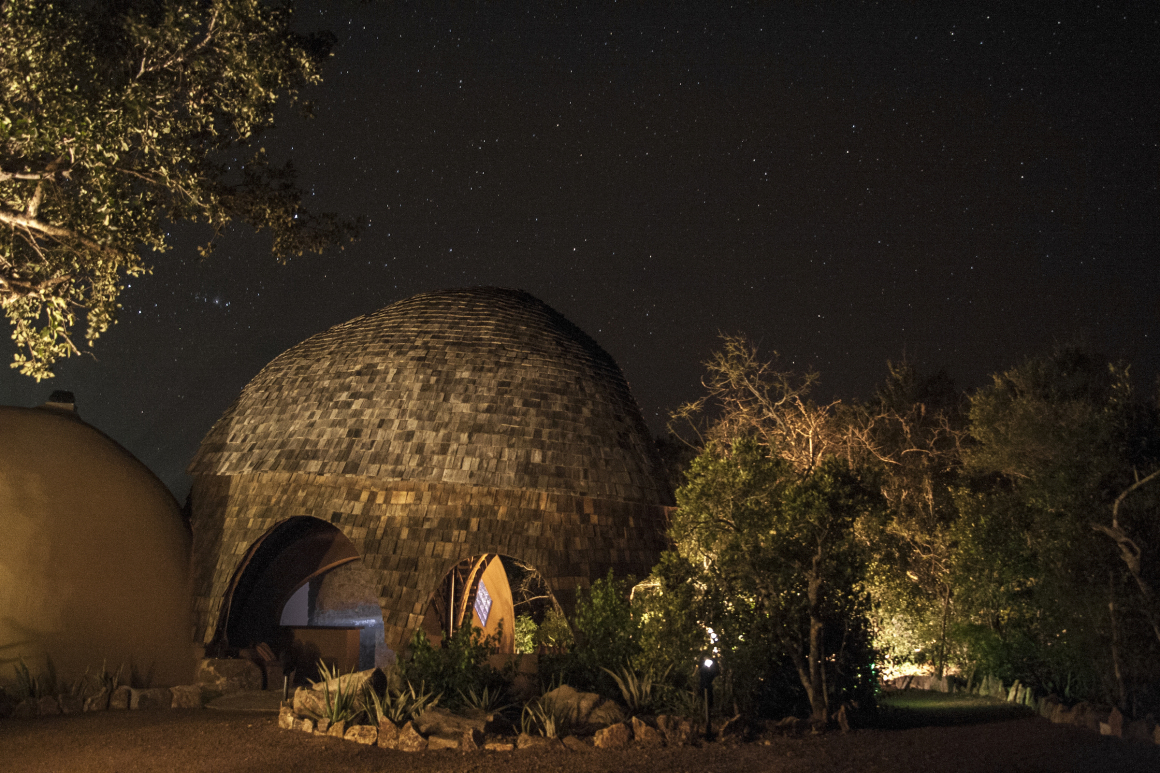
卫生间的设计也令人惊喜万分,光滑连续的黑色水磨石自然铺开,有一种在黑暗空间的孕育感,墙壁上的白色水磨石带就像穿过深色石头的白色石英脉,闪亮的铜制水龙头和浴室配件与黑色背景形成鲜明的对比,卵石状的镜子也呼应了接待中心的设计主题。
The restrooms are an unexpected discovery, where a continuous volume of smooth black terrazzo unfolds organically. The darkness of the space has a cradling effect. Bands of white terrazzo along the wall resemble white quartz veins running through dark stone. Shiny copper taps and bathroom accessories contrast against the black background. Compositions of pebble-shaped mirrors echo the central design theme.

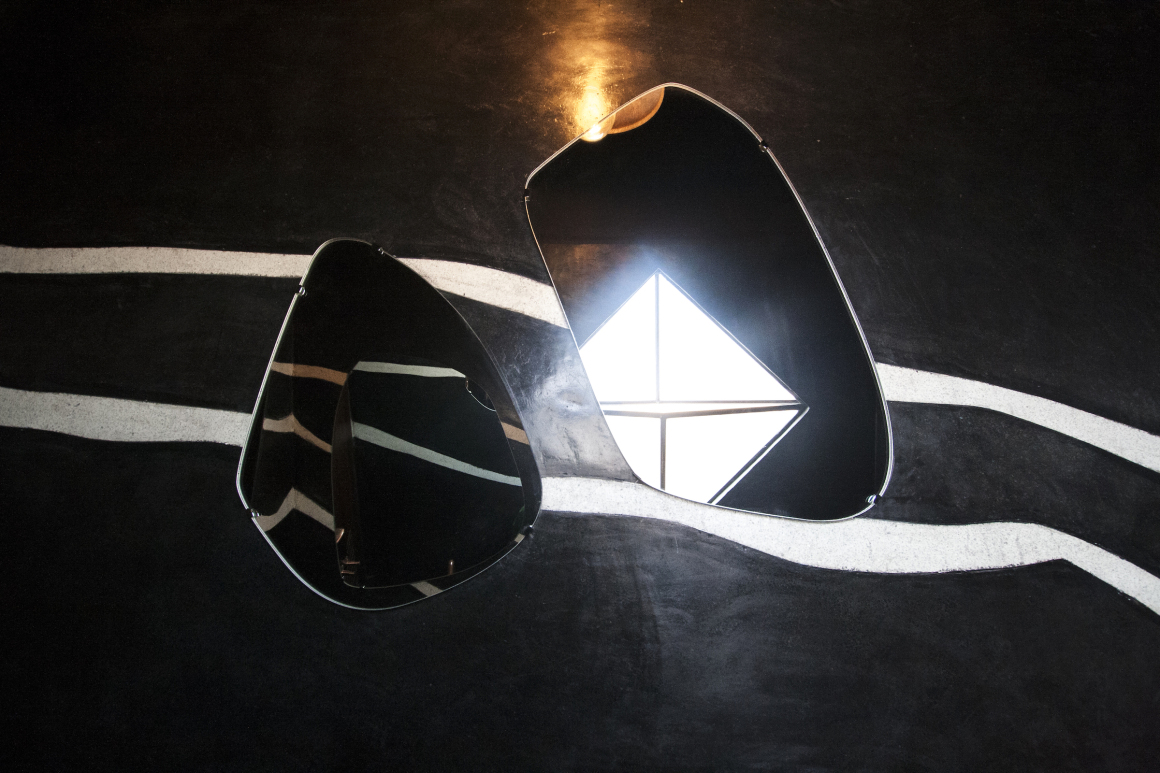
靠近海滨的主要区域由交叉的圆石状体块组成,中间是露天的酒吧和餐厅,图书馆、厨房和浴室等支持性及其它更私密的功能空间则位于后面的封闭空间。
Positioned on the beachfront, the main area is composed from intersecting boulder-shaped volumes with the open bar and restaurant in the centre. The supportive and more private functions such as the library, kitchen and bathrooms are located at the back in enclosed volumes.


酒吧、泳池 Bar and pool
Ten Tuskers酒吧以当地著名的大象画为特色,仿佛一个野生动物园客厅。中心吧台处有一面闪闪发光的石英墙和一个由铜管制成的酒瓶架,还有巨大的钟乳石造型的枝形吊灯照亮整个空间。
Designed as a safari living room the Ten Tuskers Bar features portraits of renowned local elephants. The bar counter forms the centrepiece, displaying a sparkling wall of quartz and a bottle rack fashioned from copper pipe. A giant stalactite-inspired bamboo chandelier illuminates the bar surface.

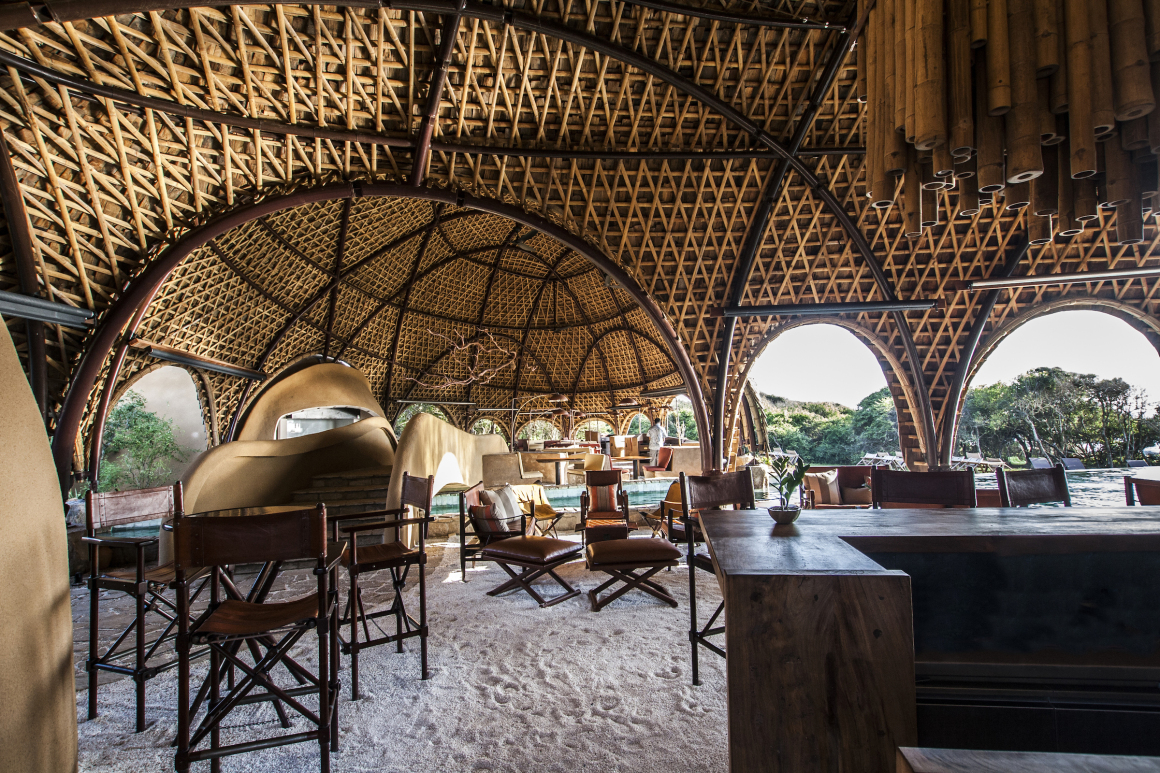

环绕在酒吧周围的泳池是该区域的一个特色节点。它将酒吧和餐厅分隔开来,只通过一座室内桥梁进行连接,作为这两个主要空间之间的过渡。客人可以从度假村一侧进入游泳池,然后游40米穿过建筑物到达海滩。泳池里的水在提供自然冷却的同时,也帮助将美丽的阳光反射到拱形的竹制天花板上。夜晚,游泳池的集成光纤灯像夜空一样闪烁,人们可以坐在酒吧里喝饮料,也可以在游完泳后,在泳池边的大卵石之间的座位上享受。这里运用的皮革、铜、红木、石英和石英卵石地板等材料,以及可移动家具,带人们回到了那个充满探索和冒险的时代。
Wrapped around the bar, the pool is a feature element in the main area. It separates the bar from the restaurant, which are connected by an indoor bridge that marks the transition between these two main spaces. Guests can enter the pool from the resort side and swim 40 metres through the building towards the beachfront. The water also provides a natural cooling effect and beautifully reflects sunlight onto the vaulted bamboo ceilings. By night the pool twinkles like the night sky thanks to integrated fibre-optic lights. Drinks can be enjoyed either seated at the bar or, while taking a rest from swimming, from one of the seating niches carved into the sides of the pool between the big boulder footings. Campaign furniture evokes an era of discovery and adventure. Materials used include leather, copper, mahogany, quartz and quartz pebble floors.

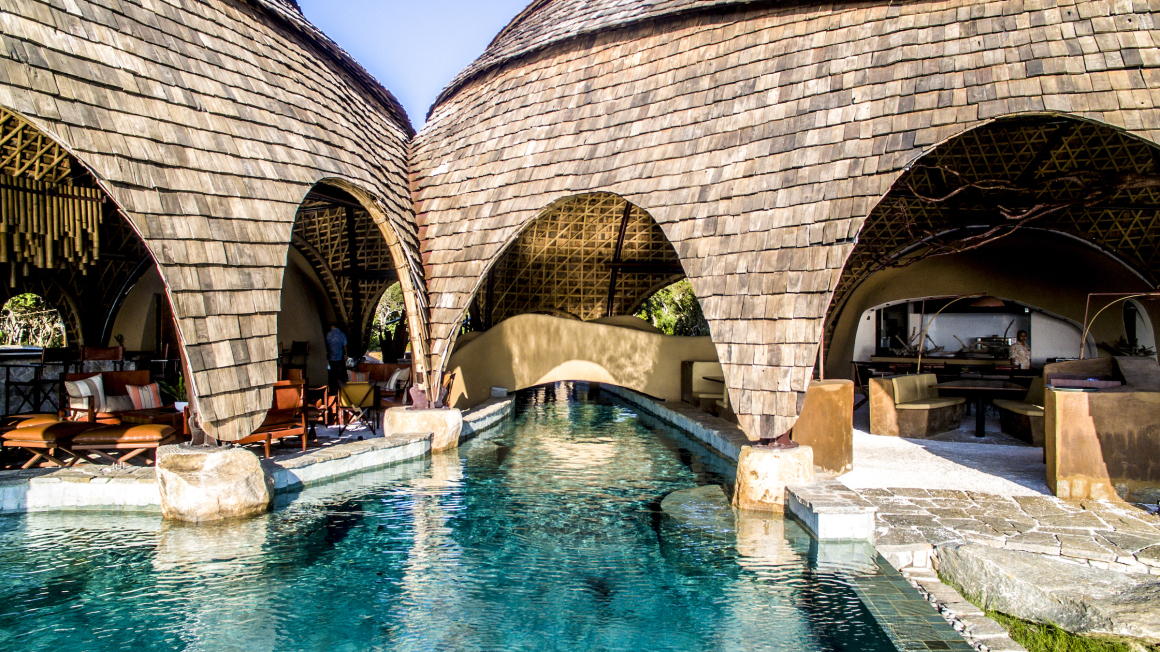
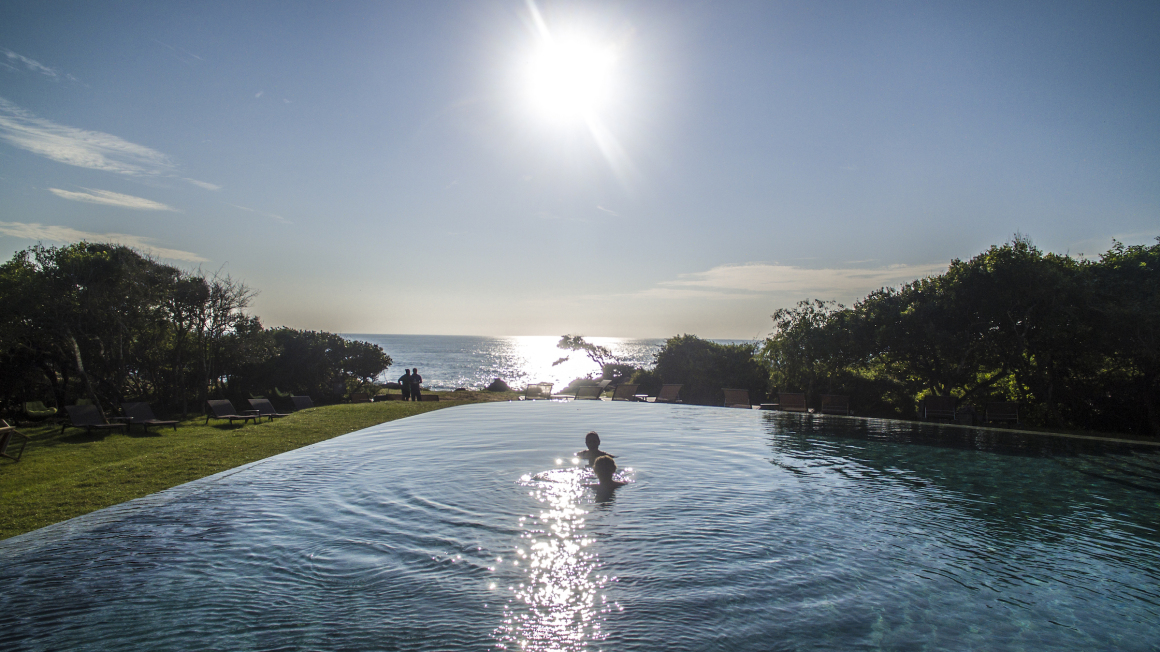
餐厅 Restaurant
面朝大海的餐厅,是这里最大的建筑物:宽敞的拱形开口、10米高的拱形天花板,以及在建筑中流动的水景,在建筑内外实现了无缝过渡;其室内设计特色主要集中在几个雕塑上;涂层泥砖壁龛中设有座位和服务站;精心设计的布局最大化了每张桌子的海景视野;悬挂在桌子上方的有机形状的铜灯平衡了泥砖的简单性和坚固感;泥砖上发光的铜灯罩和蜡烛龛给人以温暖感;白色的砾石和天然石材地板营造出独特的户外感。
Orientated towards the ocean, the restaurant is the largest pavilion. Inside flows seamlessly with the outside thanks to the generous arched openings, ten-metre-high vaulted ceiling and the movement of the water through the building. The interior focuses on several sculptural elements. Coated mud brick niches incorporate seating and service stations. The carefully-considered layout maximises ocean views for each table. Organically-shaped copper lamps hanging above the tables counterbalance the simplicity and solidity of the mud brick. The glowing copper shades and candle niches in the mud brick lend warmth. White gravel and natural stone floors create a distinct outdoor feel.
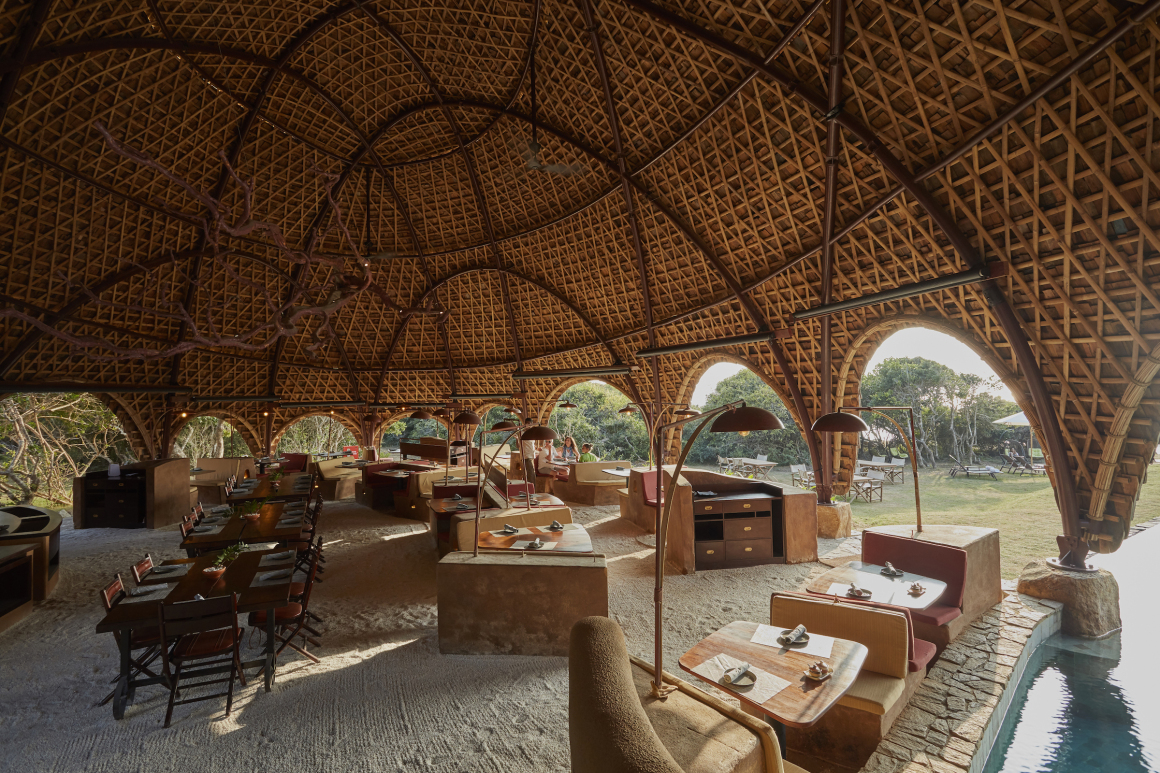
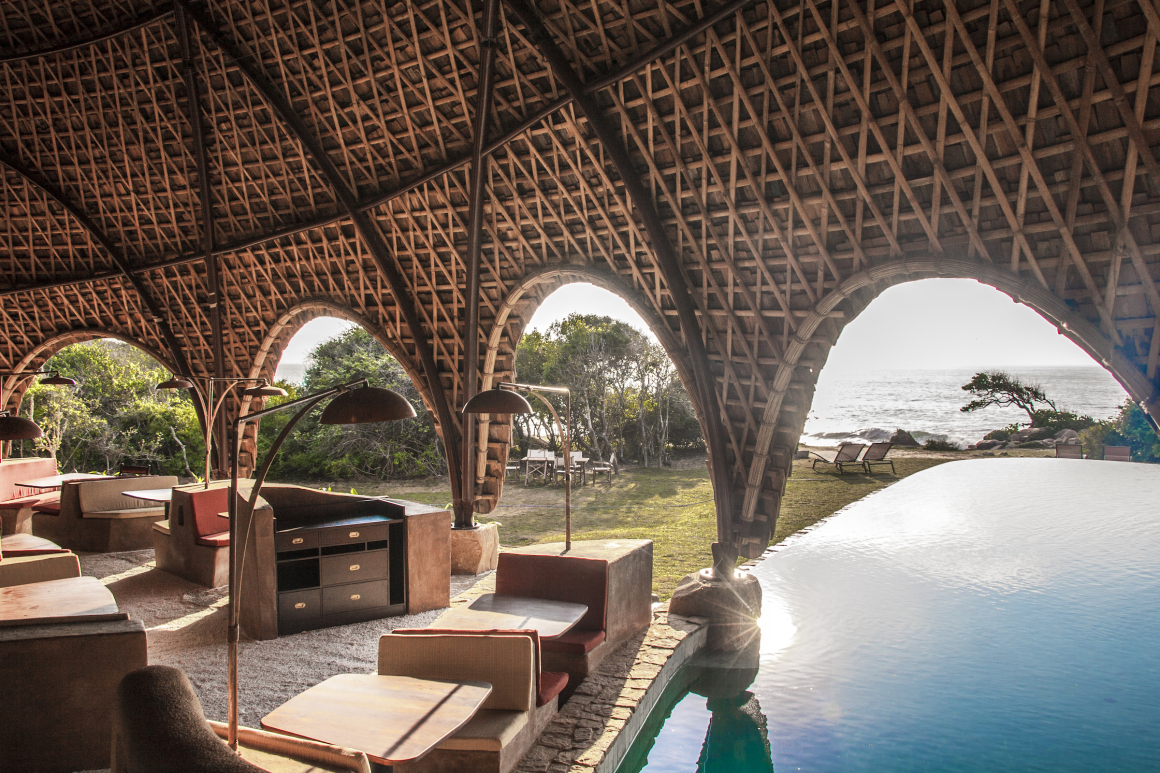
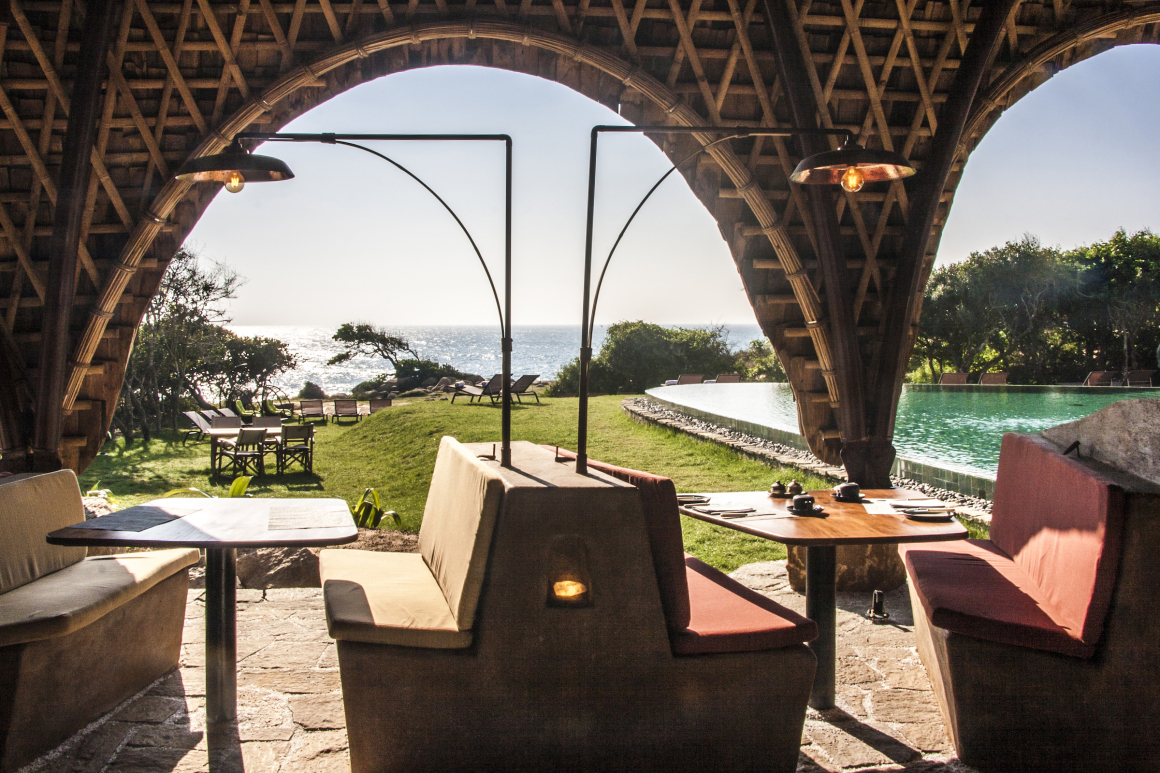
餐厅中央用于野生动物观赏前的会议和早餐的桌子,由当地一棵已死去的树龄约150岁的Kumbuk树的中间部分制成,现在制成桌子后,它又在亚拉重获了新生。拱形天花板上的视觉中心悬挂着一棵完全被铜叶覆盖着的7米长的树,这棵树也是在现场发现的,它与穹顶内部配置的同心LED环一起,进一步强调出了空间的雕塑感。
Hosting the pre-safari briefing and breakfast, the central table is fashioned from a vertical section of a huge tree trunk. Its origins lie in a 150-year-old Kumbuk tree that unfortunately died at Resplendent Ceylon’s Cape Weligama resort, but gains a new life now in Yala. Suspended in the vaulted ceiling, the visual centrepiece is a seven-metre-long illuminated tree – found on the site – covered entirely in copper leaf. Concentric LED rings on the inside of the dome further accentuate the sculptural quality of the space.
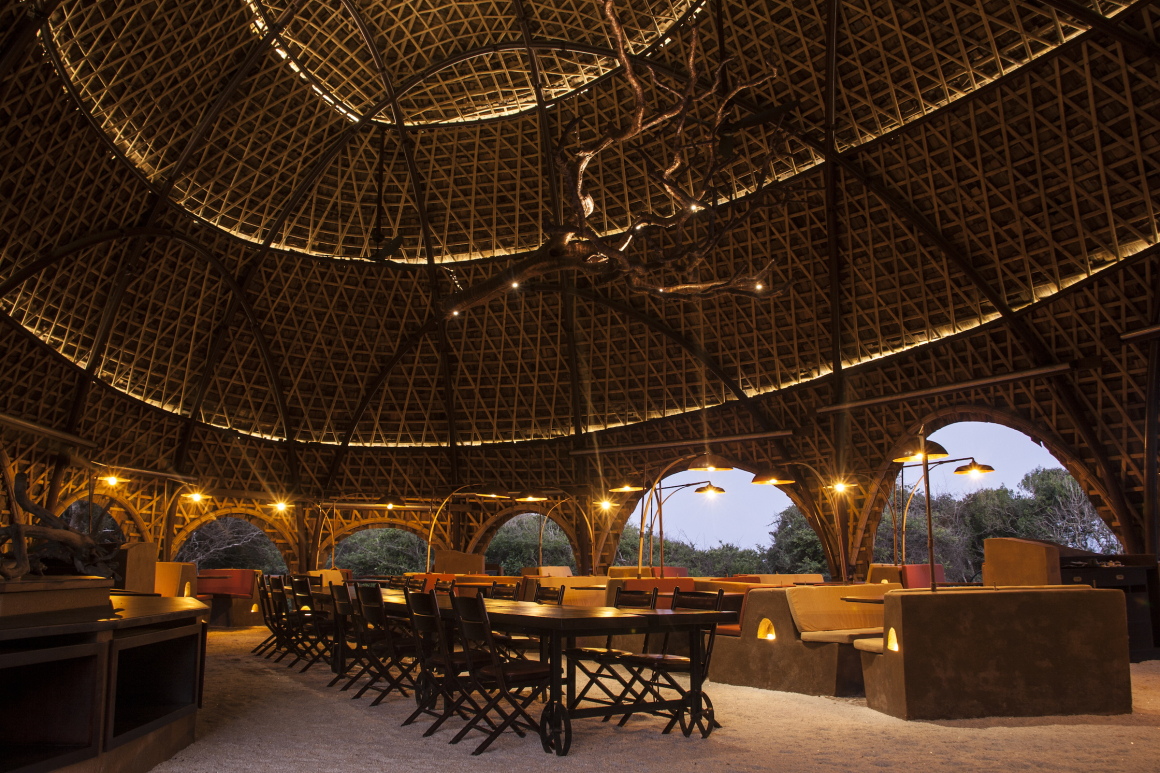
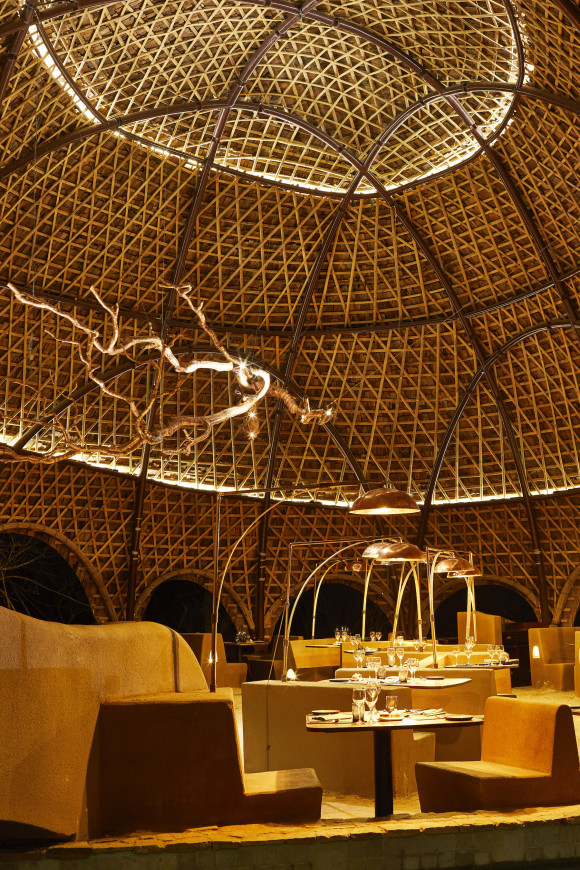
可持续性及当地工艺 Sustainability and local craftsmanship
为了最大限度地减少对环境的影响和场地的孤立性,整个项目都以场地为中心,采用可持续的方法进行设计。比如屋顶上的太阳能电池板可以满足营地40%的能源需求,食物垃圾在沼气池中集中处理,产生的沼气可供厨房使用,而产生的废水又可循环用于浇灌花园,从空调机组中回收的热量可用在循环系统中加热水。
尽可能地取材于当地,使用与周围环境相协调的天然材料,融合当地传统泥砖建筑。广泛使用当地挖掘的石头和开采的石英,将砾石筛分过程中的残余粘土与大象粪便混合在一起,建造餐厅和接待区的泥砖座椅。竹子也是一种坚固、生长迅速的可再生材料,还有回收利用的柚木瓦。
重要的是,度假村是在当地社区的密切合作下建成的。当地渔民接受了一组国际顾问的培训后,完成了竹子和帐篷的建造工程。主要展馆的巨石底座细节也是由一位专门从事寺庙雕刻的石匠建造而成,而活套的内部衬垫则是由习惯于固定渔网的手指灵巧的渔民巧妙编织而成。
The ambition to minimise environmental impact and the isolated nature of the site demanded a locally-focused, sustainable approach to the entire project. Solar panels on the roofs of the back-of-house spaces produce up to 40% of the camp’s energy needs. Food waste is processed in a gas digester producing biogas for the kitchen and grey water is recycled for watering the gardens. Heat recovery from the air-conditioning units is used for water heating in the Loopers.
Sourced locally as much as possible, natural materials were used in tune with the surrounding environment, celebrating vernacular traditions such as mud brick construction. Excavated stone and locally quarried quartz are used widely throughout, and residue clay from the gravel sieving process was mixed with elephant dung, an abundant resource, to create the restaurant and welcome area mud brick seating. Bamboo is a strong, fastgrowing renewable material and the teak shingles were reclaimed.
Importantly, the resort was built in close collaboration with the local community. Local fishermen were trained by a group of international consultants to execute the bamboo and tent construction. The boulder footing details of the main pavilions were constructed by a local rock carver who specialises in working with temples, and the interior liners of the Loopers were skilfully laced by fishermen with nimble fingers accustomed to fixing nets.
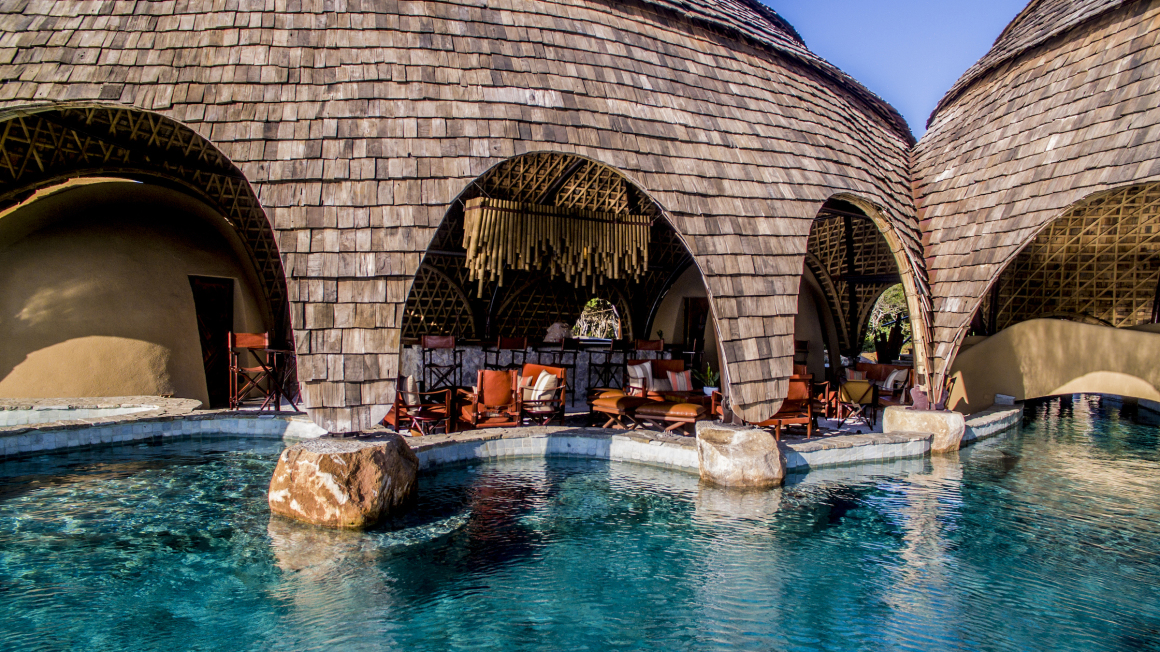
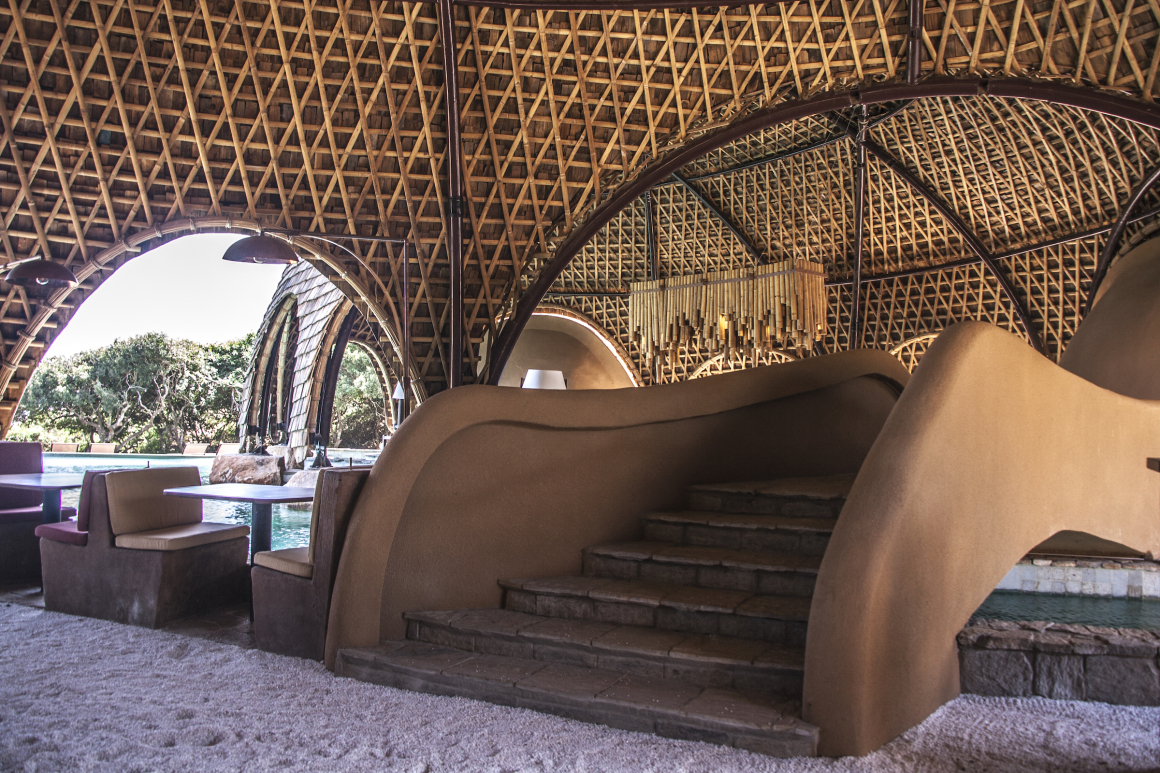

项目名称:荒野海岸帐篷度假村
完成:2017年
面积:5250平方米
项目地点:斯里兰卡 亚拉
建筑公司:Nomadic Resorts
公司网址:www.nomadicresorts.com
联系邮箱:enquiries@nomadicresorts.com
首席建筑师:Olav Bruin
设计团队:Olav Bruin, with Freddie Catlow, Inma Cantero, Oana Tudose, Julian Klaus Trummer
客户:Resplendent Ceylon
室内设计:Bo Reudler Studio
环境和MEP设计:XCO2 Energy
照片:Marc Hernandez Folguera, Nomadic Resorts, Resplendent Ceylon, Tim Evan-Cook
Project name: WILD COAST TENTED LODGE
Completion Year: 2017
Size: 5250 m2
Project location: Yala, Sri Lanka
Architecture Firm: Nomadic Resorts
Website: www.nomadicresorts.com
Contact e-mail: enquiries@nomadicresorts.com
Lead Architects: Olav Bruin
Design Team: Olav Bruin, with Freddie Catlow, Inma Cantero, Oana Tudose, Julian Klaus Trummer
Clients: Resplendent Ceylon
Interior Design: Bo Reudler Studio
Environmental & MEP design: XCO2 Energy
Photo credits: Marc Hernandez Folguera, Nomadic Resorts, Resplendent Ceylon, Tim Evan-Cook
更多 Read more about: Nomadic Resorts




0 Comments